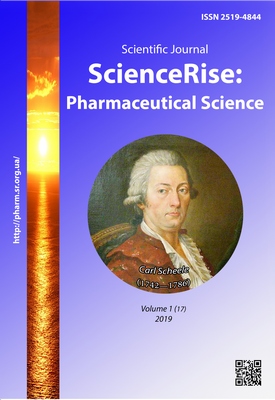Study of the stability of organoleptic and structural-mechanical indicators of semi-solid preparations with metal nanoparticles
DOI:
https://doi.org/10.15587/2519-4852.2019.158590Keywords:
silver nanoparticles, gold nanoparticles, ointments, creams, gels, stability, rheological properties.Abstract
Aim. Research of the stability of organoleptic and rheological properties of semi-solid preparations with silver and gold nanoparticles.
Methods. For the study of organoleptic parameters, a classic method for determining the stability with periodic control of dosage forms in two temperature regimens was used: 8-15 °C (cool place) and 15-25 °C (room temperature). To study the rheological characteristics of semi-solid preparations, a rotary viscometer with a system of coaxial cylinders was used.
Results. We studied three medicinal forms based on silver nanoparticles - ointment, cream and gel, which can be promising for the use in dermatology, as well as two dosage forms based on nanoparticles of silver and gold for the use in dentistry and surgery for the treatment of infectious, purulent-inflammatory diseases of skin and mucous membranes of the oral cavity. Within 24 month of storage of dosage forms in a dark place in dark glass containers every 6 months the following parameters: homogeneity, odour, colour and pH were monitored. Rheological parameters were investigated after the preparation of dosage forms and after 24 months of storage. According to the rheological indicators rheograms of stream semi-solid preparations were constructed, and also indicators of mechanical stability were calculated. It was found that all samples are coagulation systems with a pseudoplastic flow type. The obtained rheograms contain loops of hysteresis, which characterize their certain degree of thixotropy.
Conclusion. According to the results of studies the stability of organoleptic characteristics of semi-solid preparations at a storage temperature 8-15 0С in a place protected from light is established. According to the rheological properties, samples of studied semi-solid preparations have a good ability to apply on the skin and extrusion from tubes.
References
- Nastanova 42-3.3:2004. Likarski zasoby. Vyprobuvannia stabilnosti (2004). Kyiv: MOZ Ukrainy, 59.
- Guidance for Industry ANDAs: Stability testing of Drug Substances and Products (2014). U.S. Department of Health and Human Services Food and Drug Administration Center for Drug Evaluation and Research (CDER). Available at: https://www.fda.gov/downloads/drugs/guidancecomplianceregulatoryinformation/guidances/ucm366082.pdf
- Gladukh, I. V., Seguy, A. M., Nicolaychuk, N. O. (2017). The rheological studies of the gel base with a dense extract from burdock. Social Pharmacy in Health Care, 3 (3), 21–26. doi: https://doi.org/10.24959/sphhcj.17.92
- Davtyan, L. L., Vashuk, V. A., Polishchuk, Y. P. (2013). Rheological research process as the basis for creating a new drug. Farmatsevtychnyi zhurnal, 4, 54–58.
- Bilous, S. B., Marievskiy, V. F., Krolevetskaya, N. M., Vyalyh, Zh. E., Ruban, N. M., Chekman, I. S. (2011). Rationale for selection forms for external use with silver nanoparticles. Profilaktychna medytsyna, 4, 9–13.
- Bilous, S. B., Marievskyi, V. F., Vialykh, Zh. E. et. al. (2012). Otsinka antymikrobnoi aktyvnosti ta mikrobiolohichnoi chystoty miakykh likarskykh zasobiv z nanokompozytsieiu sribla. Ukrainskyi medychnyi almanakh, 12 (5), 34–37.
- Marievsky, V. F., Movchan, B. O., Chekman, I. S., Vyalyh, Zh. E., Krolevetska, N. M., Ruban, N. M., Bilous, S. B. (2013). Antibaсterial activity of new active pharmaceutical ingredient – silver nanocomposition. Profilaktychna medytsyna, 1-2 (20), 56–60.
- Rieznichenko, L. S., Rybachuk, A. V., Bilous, S. B. (2016). Silver nanoparticles: synthesis, effectiveness in treatment of purulent-inflammatory diseases of the maxillofacial area, development of dosage forms. Journal of chemical and pharmaceutical research, 8 (1), 332–338.
- Bilous, S. B., Rieznichenko, L. S., Dybkova, S. M., Rybachuk, A. V., Kalyniuk, T. H. (2018). The studies on the pharmaceutical development of dosage forms with silver and gold nanoparticles for use in dentistry and surgery. Visnik Farmacii, 4 (96), 28–36. doi: https://doi.org/10.24959/nphj.18.2228
- Derzhavna Farmakopeia Ukrainy. Vol. 1-3 (2014). Kharkiv: Derzhavne pidpryiemstvo «Ukrainskyi naukovyi farmakopeinyi tsentr yakosti likarskykh zasobiv», 1128, 724, 732.
- Gladukh, Je. V., Grubnik, I. M., Kukhtenko, G. P., Stepanenko, S. V. (2015). Rheological studies of water-ethanol solutions of gel-formers. Journal of chemical and pharmaceutical research, 7 (4), 729–734.
- Rybachuk, V. D., Ruban, O. A. (2018). Rheological study of natural zeolite paste with silica dioxide. Pharmaceutical review, 1, 23–28. doi: https://doi.org/10.11603/2312-0967.2018.1.8598
- Nastanova Likarski zasoby. Nalezhna vyrobnycha praktyka ST-N MOZU 42-4.0:2015.
- Baranova, I. I. (2013). Determination of shelf-lives and storage conditions for gels with fresh-water sponge. Visnyk farmatsiyi, 3, 27–30.
- Rukhmakova, О. А., Yarnykh, Т. G. (2015). The stability studies of ointment for the treatment of allergic dermatitis complicated by fungal infection. Ukrainian biopharmaceutical journal, 3, 28–31.
Downloads
Published
How to Cite
Issue
Section
License
Copyright (c) 2019 Svіtlana Bilous, Inna Kovalevskaya

This work is licensed under a Creative Commons Attribution 4.0 International License.
Our journal abides by the Creative Commons CC BY copyright rights and permissions for open access journals.








